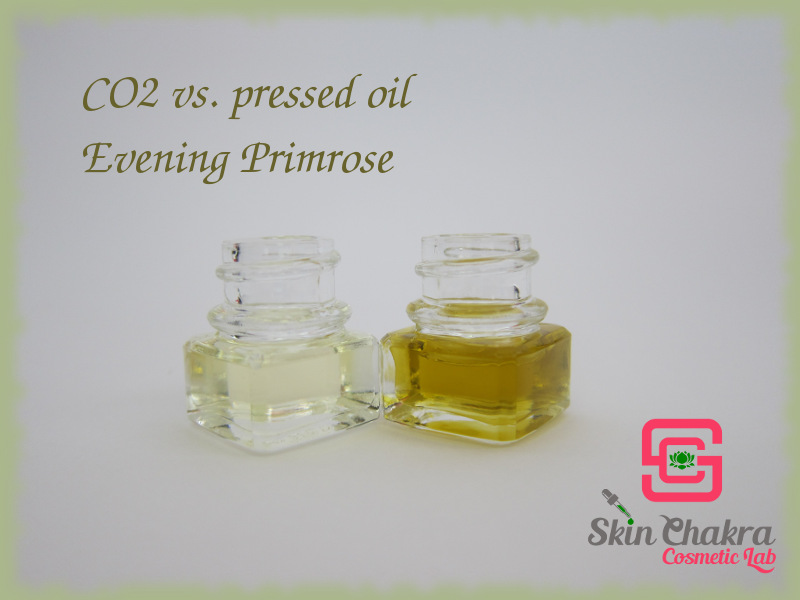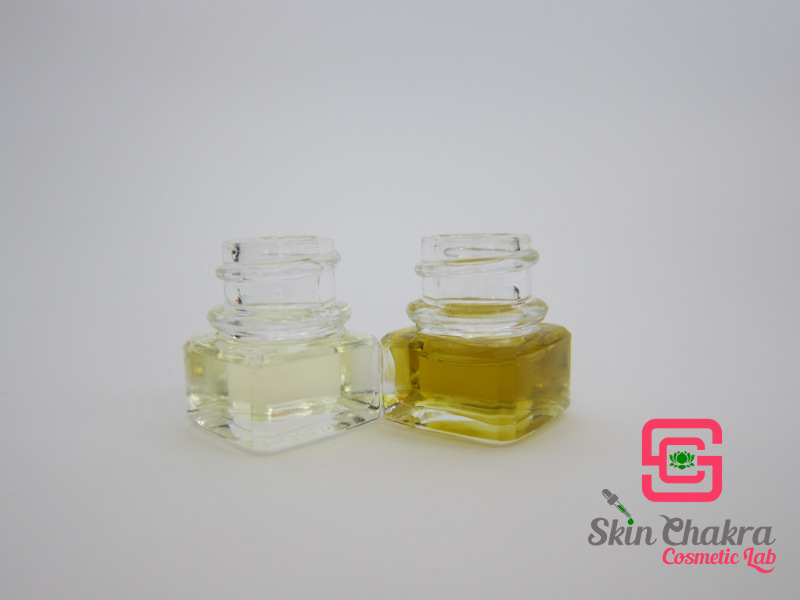
Donnerstag, 28. September 2017
Pressed oil vs. CO2 extract: Evening Primrose

CO2 extracts are becoming extremely popular in food, pharmaceutical and cosmetic industry however they are still a big mystery to most formulators (and even to most retailers). In this post, we're going to compare CO2 extract and pressed oil of evening primrose ( Oenothera Biennis ), one of the most popular anti-inflammatory oil/active ingredients in skincare.
Read our previous posts about CO2 extracts and their comparision to pressed or essential oils:
Pressed oil vs. CO2 extract: Rose hip
Pressed oil vs. CO2 extract: Borage
The Queen of Spices: Cardamon
Evening primrose oil is one of the most popular anti-inflammatory oils in cosmetic formulations. We offer both the organic cold pressed oil and the organic CO2 extract on our online shop.
It is not only a popular oil in the cosmetics. Its high concentrations of linoleic acid and gamma- linolenic acid make it an ideal dietary supplement for omega-6 fatty acids. Omega-6 fatty acids belong to the essential fatty acids that could not be built in the body and should be taken with food. They are involved in almost all metabolic processes in our bodies.
Consuming rich in gamma-linolenic acid food such as evening primrose oil favours the formation of Prostaglandin E1 with anti-inflammatory properties. There are studies that even show the efficacy of evening primrose oil in reducing the tumor size in patients affected with liver cancer1 . Since these activities are beyound the scope of our interest we'll focus on cosmetic applications.
Evening primrose oil is a remedy for sensitive and damaged skin (as far as a cosmetic product can help damaged skin and don't trespass the border to medicine). Its anti-inflammatory and barrier repair properties are used in all forms of preparations for sensitive, scaly, dry and damaged skin.
Let's have a look at the CO2 extract and the cold pressed oil:

Both the oil and CO2 extract are obtained from the seeds. The oil has a much lighter colour (the left bottle) compared to the CO2 extract (at least this is the case in our samples).
(Our supplier has added 0.1% organic rosemary extract to the organic CO2 extract to enhance its oxidation stability). High in unsaturated fatty acids, evening primrose oil is a very sensitive oil. The oil usually becomes rancid even before the nominal expiry date but like many other cases, the CO2 extract has a much longer shelf-life compared to the pressed oil.
| Evening primrose Pressed oil | Evening primrose CO2 extract | |
| CAS# | 90028-66-3 | 90028-66-3 |
| EINECS# | 289-859-2 | 289-859-2 |
| INCI name | Oenothera biennis oil | Oenothera biennis seed extract |
| Density (20 oC) | 0,925 g/cm3 | 0,910-0,940 |
| Refractive index (20 oC) | 1,4759 | 1,4760 - 1,4810 |
| Acid value | <4,0 mg KOH/g | <12 mg KOH/g |
| Sap. value | 193 mg KOH/g | 193 mg KOH/g |
| Peroxide value | <10 meq O2/kg | <15 meq O2/kg |
| Unsaponifiables | 1,7% | 3,5% |
| Fatty acid composition | ||
| Palmitic acid (C16:0) | 6,3% | 6,1% |
| Stearic acid (C18:0) | 2,2% | 1,9% |
| Oleic acid (C18:1) | 7,2% | 7,1% |
| Linoleic acid (C18:2) | 73,3% | 74,5% |
| Gamma-Linolenic acid (C18:3) | 8,9% | 9,7% |
| Palmitoleic acid (C16:1) | trace | 0,05% |
| Vaccenic acid (C18:1) | trace | 0,38% |
| alpha-Linolenic acid (C18:2) | trace | 0,19% |
| Arachidic acid | trace | 0,21% |
| Unsaponifiables | ||
| Sterols | 0,96% | 0,94% |
| Tocopherols | 770 ppm | 300 ppm |
The fatty acid profile of the oil and CO2 extract are very similar. The unsaponifiables for the CO2 extract is higher compared to the pressed oil but this could be smething charge related. Both oil and extract contain tocopherols. The tocopherol content in the oil is almost twice as in the CO2 extract. Gamma-tocopherol is the predominant tocopherol isomer.
Almost 44% of the unsaponifiables are phytosterols with beta-sitosterol as the main component. The sterol content of the oil and the CO2 extract is amazing (over 9000 ppm!!)
The most important difference between the pressed oil and the CO2 extract is in the presence of three triterpenoid esters with anti-inflammatory and radical scavenging properties in the CO2 extract that are not as much present in the pressed oil. It seems that even in cold pressed oil, the heat produced because of the mechanical friction destroys these active ingredients1,2.
These triterpenoid esters are: betulinic, morolic, and oleanolic acid. None of my oil or CO2 extract suppliers mention these esters of caffeic acid in the data sheet (because the mainstream industry is not interested in these active ingredients!!). This is a comparison table from the literature1:
| Process | Betulinic acid (mg/100 gr) | Morolic acid (mg/100 gr) | Oleanic acid (mg/100 gr) |
| CO2- Extraction | 24,5 | 22,6 | 10,6 |
| Cold pressing | 11 | 10,3 | 4,5 |
| Refined oil | 0,7 | 0,5 | 0,05 |
Hope you find this information useful and helpful. The information are charge related and are based on the data sheet we have received from our suppliers. These contents may vary slightly from charge to charge.
BeHappy and have fun
1- Krist, Sabine, Gerhard Buchbauer, and Carina Klausberger. Lexikon der pflanzlichen Fette und Öle. Springer-Verlag, 2009.

